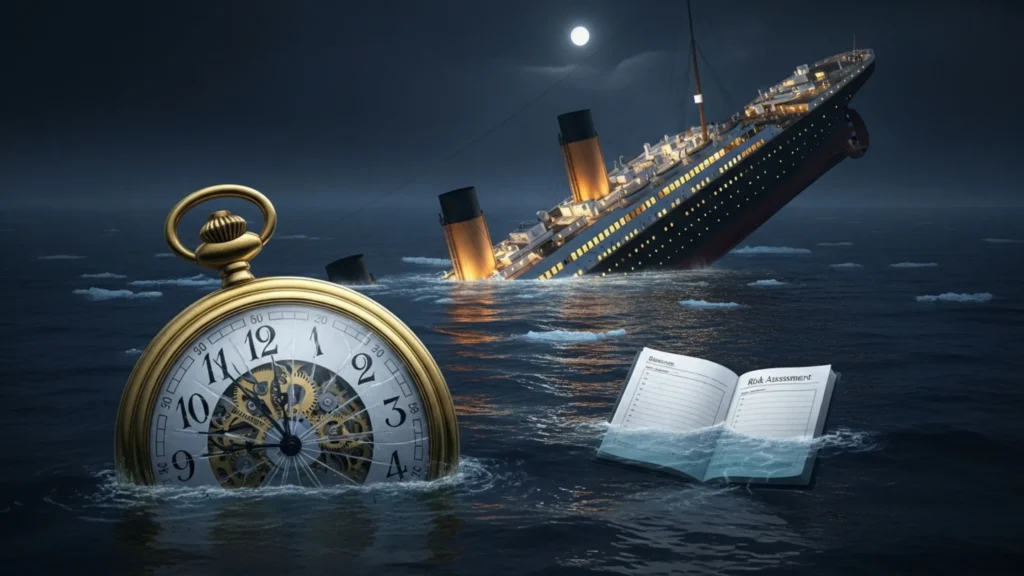What the Titanic Can Teach You About Business Risk

What the Titanic Can Teach You About Business Risk is not merely a lesson in maritime history; it is a chilling corporate case study on the peril of hubris and inadequate preparation.
Anúncios
The sheer scale of the 1912 disaster offers timeless, brutal clarity on risk management, or the catastrophic failure thereof.
The tragedy provides a perfect, albeit heartbreaking, analogy for the modern corporate world, highlighting how overconfidence in current technology or market dominance can lead to total, avoidable collapse.
Every business leader, from a Silicon Valley startup founder to a Fortune 500 CEO, should study the Titanic’s maiden voyage as a cautionary tale.
The ship’s fate reveals that perceived invincibility is the biggest blind spot in any risk assessment strategy.
Anúncios
Why Did Overconfidence Sink the Ship and How Does That Relate to Business?
The architects and owners of the Titanic marketed the vessel as “unsinkable,” a perception rooted in advanced (for the time) shipbuilding and a profound sense of technological superiority. This overconfidence bred fatal complacency.
How Does the “Unsinkable” Mindset Manifest in Modern Business?
That “unsinkable” delusion manifests today when market leaders assume their brand, scale, or technology is immune to disruption. They ignore emerging competitors, dismiss internal warnings, or delay necessary infrastructure updates.
Consider the recent turmoil in the tech sector, where massive, established companies, blinded by multi-year success, failed to pivot rapidly enough. They underestimated the speed of AI integration or the shift in consumer sentiment.
This corporate hubris often leads to reckless speed, forcing the company to barrel through known threats without reducing pace.
The icy warnings the Titanic received from other ships were disregarded, precisely because the ship felt invincible. The initial success of a business can ironically become its greatest vulnerability.
A 2016 study published in the International Small Business Journal found that a majority of entrepreneurs were prone to overconfident budgetary forecasts, and this cognitive bias was directly associated with subsequent firm failure.
Leaders must replace self-assuredness with continuous, humble assessment.
++ The Only Country That Ever Declared Bankruptcy 9 Times
What is the Danger of Relying Solely on Compliance?
The Titanic famously complied with, and even exceeded, the outdated British Board of Trade regulations regarding lifeboat capacity.
The law mandated only 16 lifeboats for a ship of its tonnage, yet the ship carried 20. Compliance, therefore, is the baseline, not the ceiling, of sound risk management.
A business that only follows the minimum regulatory requirements risks catastrophic failure when an unforeseen event a regulatory shift, a zero-day exploit, or a market crash occurs.
Modern businesses frequently face this peril in cybersecurity. They pass a basic security audit, yet they remain vulnerable to sophisticated, state-level cyberattacks that compliance standards do not anticipate.
Being merely compliant is the corporate equivalent of carrying enough lifeboats for only a third of the people on board.

What Does the Lifeboat Shortage Reveal About Preparedness?
The most visceral lesson from the disaster involves the insufficient lifeboats enough for only 1,178 people, while over 2,200 were aboard.
This staggering deficit was a physical manifestation of a psychological failure to plan for total loss.
Also read: How Rich Was Cleopatra, Adjusted for Inflation?
Why Should Critical Contingencies Never Be Cosmetic?
The Titanic was built with the capacity to carry 64 lifeboats, a number originally planned by the designer, Alexander Carlisle.
That number was drastically reduced to 20 for “aesthetic reasons” to keep the deck uncluttered for first-class passengers.
In the corporate world, this translates to neglecting disaster recovery plans because they are deemed too expensive or cumbersome.
Business continuity plans, data backups, and multi-supplier supply chains are often dismissed as clutter until the moment of crisis.
A company with insufficient disaster planning risks a full-scale shutdown from an easily preventable event.
For instance, in 2025, acute supply chain failures due to geopolitical tensions are a primary global risk, yet many businesses still rely on single-source suppliers to save marginal costs.
The Titanic’s designers prioritized the comfort and luxury experience over maximum safety. Ask yourself: is your business prioritizing short-term profitability over genuine, disaster-ready resilience?
Read more: Stories of Entrepreneurs Who Turned Crises into Opportunities in 2025
How Can We Measure the True Gap in Business Preparedness?
The gap between the Titanic’s actual capacity and its carried capacity highlights a critical business metric: the Risk Gap.
This gap is the measurable difference between the resources you need to survive a catastrophic event and the resources you currently have.
| Risk Management Element | Titanic Example (Physical Capacity) | Business Analogy (Digital Capacity) | Risk Gap Outcome |
| Required Safety Measure | 64 Lifeboats (Full Capacity) | Comprehensive Hybrid Cloud DR Strategy | Total Inability to Recover |
| Actual Safety Measure | 20 Lifeboats (Minimal Compliance) | Basic Offsite Data Backup (Not Scalable) | Loss of Key Functions & High Downtime |
| Consequence of Neglect | 1,500+ Lives Lost | Major Financial Loss, Reputational Damage | Brand Trust Erosion |
Why is Practice More Important Than the Plan Itself?
Even the lifeboats that were launched were not filled to capacity, often carrying only a fraction of the 65 people they could hold.
This failure was due to a lack of training, confusion about procedures, and panic. Having a plan is necessary, but executing and practicing that plan under pressure is essential.
A company can have a beautifully written incident response manual, yet if the team has never simulated a live cyberattack or a critical system failure, the plan is worthless paper.
Regular, unannounced stress tests of business continuity plans are the modern equivalent of lifeboat drills.
This preparedness minimizes human error under duress, ensuring an orderly response when the digital iceberg hits.
Do you know, definitively, who is in charge of your company’s emergency response, and have they practiced their role?
What Lessons About Leadership Should be Applied Now?
The actions of Captain E.J. Smith, who followed the standard but outdated practices of his time, underscore the responsibility of leadership to champion foresight over tradition.
Why Should Leaders Challenge Historical Success Metrics?
Captain Smith was a seasoned, respected mariner, yet his adherence to the status quo fast speeds through known ice fields proved fatal.
This mirrors leaders in 2025 who cling to old business models or refuse to invest in transformative, disruptive technologies like quantum computing or specialized AI, simply because “it’s always worked this way.”
Leadership requires the courage to challenge internal assumptions and to reject the “unsinkable” narrative the market may project.
What the Titanic Can Teach You About Business Risk is that the single greatest risk is the refusal to change your course.
If your business is the Titanic, your IT infrastructure is the hull, and your contingency plan is the lifeboats.
If you declare your hull “unsinkable” and only carry enough lifeboats to comply with 1912 standards, you are destined for a historical, avoidable tragedy.
Conclusion: The Iceberg is Always Ahead
What the Titanic Can Teach You About Business Risk boils down to three points: reject the myth of invincibility, prioritize actual resilience over mere compliance, and practice your failure scenarios relentlessly.
The “unsinkable” business is the one that rigorously questions its own structural integrity every single day.
The icebergs of economic downturn, cyber warfare, or supply chain collapse are not theoretical; they are a perpetual reality in the modern market. Don’t let complacency be the reason your brand becomes a cautionary tale.
Share your experience in the comments: What is the biggest “iceberg” your industry faces in late 2025, and what is your company doing to prepare?
Frequently Asked Questions (FAQ)
Is the Titanic analogy still relevant for today’s complex digital risks?
Absolutely. While the threat has moved from icebergs to cyber threats and data breaches, the core principles of failure remain the same: overconfidence, under-preparedness, and the prioritization of cosmetic appeal (e.g., fast growth numbers) over essential safety infrastructure (e.g., robust disaster recovery).
How can a small business avoid the ‘lifeboat’ mistake?
A small business should focus on the Recovery Time Objective (RTO) and Recovery Point Objective (RPO) for their most critical operations.
Instead of buying “more boats” (costly infrastructure), they should invest in cloud-based backup solutions and simple, documented failover procedures that ensure minimal downtime and data loss.
Doesn’t aggressive speed (like the Titanic’s) lead to success in high-growth markets?
Aggressive speed is necessary, but only when paired with hyper-vigilant risk awareness. The Titanic failed because it refused to slow down in a known danger zone.
Successful high-growth businesses achieve speed by building a secure, agile foundation, not by cutting corners on essential safety protocols.
